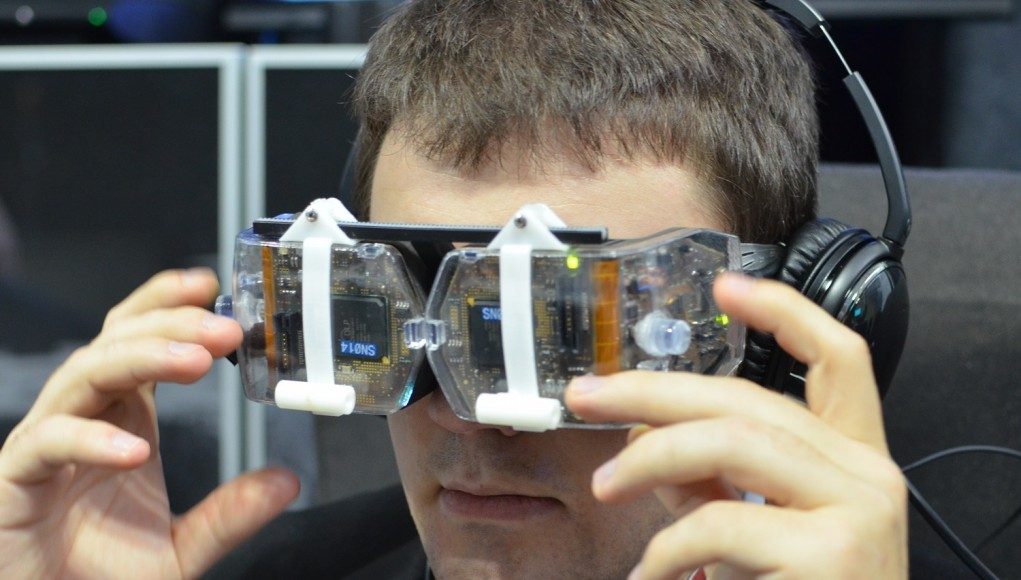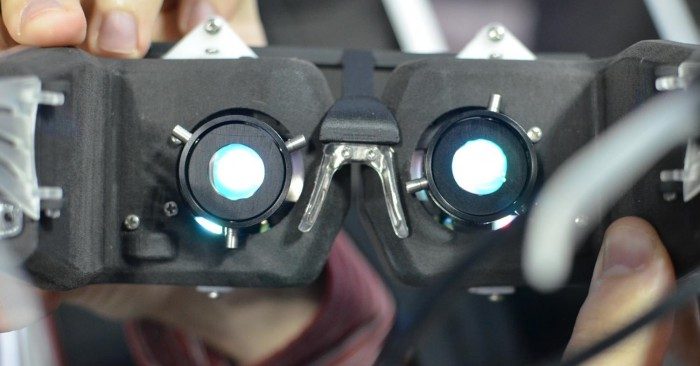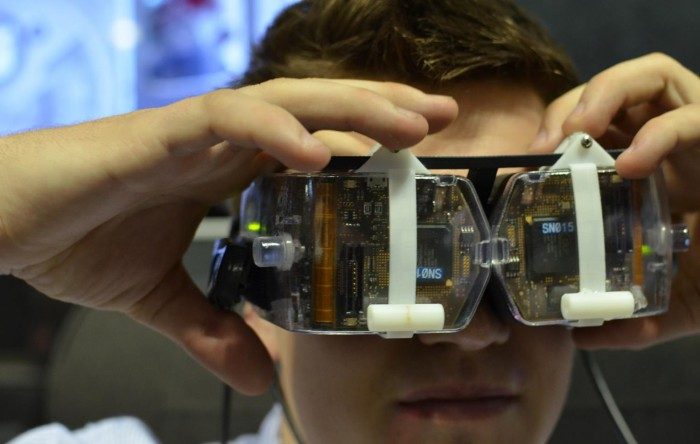Avegant is creating a unique head mounted display that uses an impressive virtual retinal display, a screen-less technology that projects an image directly onto your retina. After trying the Avegant HMD for myself, I sat down with CEO Edward Tang to learn more.
After reading Engadget’s glowing reaction to the supposedly unnamed Avegant HMD (a little digging revealed Verus as a possible name), I was pining to give it a try myself. I met up with Avegant at Engadget Expand New York this past weekend to try on the unique head mounted display. I came away extremely impressed and hopeful for things to come from the company.
The Avegant HMD uses a virtual retinal projection display (VRD) consisting of a single LED light source and an array of micro-mirrors. This differs from normal screens in that with a VRD there is no actual screen to look at. Instead, a virtual image (in the optical sense) is drawn directly onto your retina. Avegant tells me that the secret sauce to the incredible image quality is the device’s ability to separate where the light of the image is generated from where it is modulated.
Update (11/12/2013): I asked Avegant CEO Edward Tang to clarify how the VRD works
The way the image is created is first by generating light with a single low-power 3-color LED. We sequence through the colors on the LED so no color filters necessary. The light is conditioned to be as natural as possible before it hits the array of micromirrors, then it gets reflected into your eye. Remember that there is no screen, and that the image is never formed until it hits your retina.
It took years to create and scale this custom optical deign to generate both a very comfortable, natural light source and to project onto the retina correctly.
Continue Original Article:
The current prototype supports IPD and individual diopter (eye focus) adjustments, both of which are expected to carry over to the consumer release.
Incredible Image Quality
I saw two different demos using the Avegant HMD prototype. The first of which was a series of standard side-by-side 3D videos, running from a laptop, which absolutely blew me away.
At one point I was looking at a sea turtle in shallow coral waters. Sunlight was beaming down from the surface and illuminating the turtle’s shell in a spectacular way—it was one of the most vivid and natural things I’ve ever seen on any display. The scene before me looked incredibly real, even though the field of view is not at immersive levels.
The image quality was also extremely impressive. The videos I saw looked to be at least 1080p to my eyes, but Avegant told me that they were only 720p, and while the Avegant HMD technically doesn’t have pixels, the micro-mirror array (and thus ‘resolution’) is 1280×800. Perhaps it’s the 100% fill factor, or the more natural light—whatever the case—I’m now a believer that there is more to a display’s quality than resolution. Avegant is definitely on to something special here.
It should be noted that I saw some blurring on around the edges of the image, but Avegant assured me that it would be fixed in future iterations.
“Source Agnostic”
The second demo I saw was Call of Duty: Ghosts, with headtracking, running on a PS3. This highlights one of Avegant’s big advantages: plug and play compatibility with lots of existing content and devices. The headtracking to controller mapping was done using a third-party box.
In my interview (above), Avegant CEO Edward Tang told me that they want the HMD to be as “source agnostic” as possible, with the end goal being a battery operated display which could be used anywhere from your computer to your smartphone to your game console.
Call of Duty: Ghosts didn’t look nearly as good as the side-by-side 3D videos and instead looked closer to what I would expect from a normal 720p display. I noticed some significant color-fringing when turning my head. The discrepancy was jarring… how could the same display look markedly different from one piece of content to the next (I saw absolutely no color fringing with the prior demo)? When I asked about this, Tang told me that Call of Duty: Ghosts unfortunately only runs at 540p on the PS3. He also suspected that the signal may have been interlaced, which could explain the color fringing. I’m also fairly certain that the game was not running in 3D. It’s possible that real world imagery is better represented with VRD technology than CGI; I’ll need to get my head back into the Avegant with more content to be sure.
Virtual Reality and the Avegant HMD
While the display quality might have been amazing with the right content, the 45 degree field of view positions the Avegant HMD more toward consumption of existing content than immersive virtual reality. Tang told me that Avegant wants to support the massive library of existing content and games that are out today rather than waiting for the creation of immersive VR content.
I was happy to hear Tang tell me that there’s no technical reason they can’t push their tech to a field of view suitable for immersive virtual reality. I get the sense that Avegant wants to get things stable with their HMD as primarily a content-consumption device, but that they’ll be watching the VR world carefully and possibly move in that direction when the time is right—and I certainly hope that they do—having the same display quality with an immersive field of view would be positively amazing.
Crowd-funding Planned for Q1 2014

Avegant plans to take their VRD head mounted display to a crowd-funding platform in Q1 of 2014 and intends to have the product in consumer’s hands later that year. So far the company isn’t mentioning anything about pricing.
Tang told me that the prototype I saw was primarily a proof of concept and that they expect the final form-factor to shrink significantly. Avegant CTO Yobie “The Yobster” Benjamin teased me with some exciting form-factor possibilities, a few concepts of which Avegant shared with Road to VR (above right).










